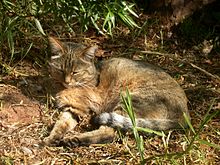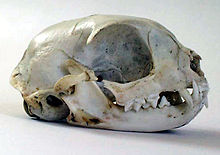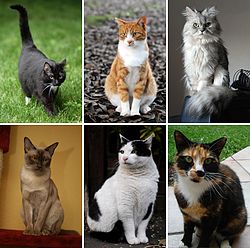
The wildcat Felis silvestris is a close relative and possible ancestor of the domestic cat.
All the cats in this genus share a common ancestor that probably lived around 6–7 million years ago in Asia.Although the exact relationships within the Felidae are still uncertain, both the Chinese Mountain Cat and the African Wildcat are close relations of the domestic cat and are both classed as subspecies of the Wildcat Felis silvestris. As domestic cats are little altered from wildcats, they can readily interbreed. This hybridization may pose a danger to the genetic distinctiveness of wildcat populations, particularly in Scotland and Hungary.
The domestic cat was first classified as Felis catus by Carolus Linnaeus in the tenth edition of his Systema Naturae of 1758. However, because of modern phylogenetics, domestic cats are now usually regarded as another subspecies of the Wildcat Felis silvestris. This has resulted in mixed usage of the terms, as the domestic cat can be called by its subspecies name, Felis silvestris catus. Wildcats have also been referred to as various subspecies of F. catus, but in 2003 the International Commission on Zoological Nomenclature fixed the name for wildcats as F. silvestris. The most common name in use for the domestic cat remains F. catus, following a convention for domesticated animals of using the earliest (the senior) synonym proposed. Sometimes the domestic cat is called Felis domesticus or Felis domestica, the term coined by German naturalist Johann Christian Polycarp Erxleben in 1777. These are not valid taxonomic names, and Linnaeus' binomial takes precedence.
Cats have either a mutualistic or commensal relationship with humans. However, in comparison to dogs, cats have not undergone major changes during the domestication process, as the form and behavior of the domestic cat are not radically different from those of wildcats, and domestic cats are perfectly capable of surviving in the wild. This limited evolution during domestication means that domestic cats tend to interbreed freely with feral cats, which distinguishes them from other domesticated animals. However, several natural behaviors and characteristics of wildcats may have preadapted them for domestication as pets.These traits include their small size, social nature, obvious body language, love of play and relatively high intelligence; they may also have an inborn tendency towards tameness.
There are two main theories about how cats were domesticated. In one, people deliberately tamed cats in a process of artificial selection, as they were useful predators of vermin. However, this has been criticized as implausible, because there may have been little reward for such an effort: cats do not carry out commands and, although they do eat rodents, other species such as ferrets or terriers may be better at controlling these pests. The alternative idea is that cats were simply tolerated by people and gradually diverged from their 'wild' relatives through natural selection, as they adapted to hunting the vermin found around humans in towns and villages.




